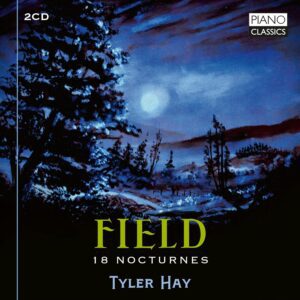Tyler Hay relates to John Field’s Nocturnes much as Claudio Arrau did to those of Chopin. In contrast to Benjamin Frith’s lightness and transparency or John O’ Conor’s charm and lyricism, Hay’s largeness of scale transports Field’s Nocturnes from the salon to the stage.
To cite one example, Frith floats the C minor No. 2’s right-hand melodies over a steadily undulating left-hand arpeggio bed, while Hay engages in inflected dialogues between the hands, with bass lines and inner voices more to the fore. The wonderful harp-like delicacy of Frith’s F major No. 6 contrasts with Hay’s vocally informed shaping of the melodic repeated notes. In the E-flat No. 9, Hay sculpts the accompaniment’s dynamics and deploys expressive tenutos in ways that circumvent the music’s squareness.
I’ve always found the C major No. 15 rather trite and simplistic, yet Hay’s tempo fluctuations and emphatic accents manage to minimize these qualities. However, those accustomed to O’Conor’s intimately shimmering G major No. 12 may be taken aback by Hay’s unsentimental and even aggressive reading. Conversely, his overly protracted A major No. 4 adds up to misplaced profundity. These quibbles should not detract collectors seeking a distinctive John Field Nocturne cycle on a modern concert grand to complement Miceál O’Rourke (Chandos) or Frith, along with Ewa Poblocka’s masterful period-instrument set (NIFCCD). Ates Orga provides informative and detailed annotations.
































